Snake identification is necessary and important for many different people. You might want to identify a pet snake, or know if the snake in your backyard or in the area is venomous. Or maybe you are just curious about snakes. Whatever the case, this article will help you to identify some of the most common snake species.
Identifying a snake can be tricky since several species look alike. It’s very easy to confuse one species with another. Even with a guide, if you want to be certain, it’s best to consult an expert. You cannot use this guide in place of a scientific textbook.
Table of Contents
Identifying a snake
The following observations can help you to identify a snake’s species. Looking at these will help you narrow down the species. Characteristics of the species such as geographical location, color and pattern of markings on the skin, the habitat where you find the snake, the size of the reptile, the shape, texture, and behavior can all help you identify the snake.
Geographical Range
If the snake is wild, the location can help you identify the snake. Different species can be found in different places. It is extremely unlikely to have wild snakes in a location where it isn’t endemic. As such, the locale where the snake is found will help you decide the species. For instance, do not expect to find a wild milk snake in California.
Regardless, it is important to know that pet snakes may be released into foreign biomes. This is especially true of snakes commonly kept as pets such as boas, constrictors, and pythons. The Burmese pythons are quite common in the wild in Florida since the climate there is quite conducive for this exotic species.
Habitat
Even within the same geographical range different snakes can be found in different habitats. Some snakes such as bullsnakes prefer dry biomes such as deserts. Others such as milk snakes prefer forests. Some including the kingsnakes can be found in grasslands. Some can also be found in water. The habitat within which the snake is found can help you to narrow down the species.
Color & Pattern
Different wild species have different patterns and colors. Wild snakes of the same species or subspecies have the same coloration and patterns. The color range is large and includes almost all visible colors that exist.
The patterns are much more limited. If you are to find a wild snake it will have one of these patterns.
Uniform or patternless
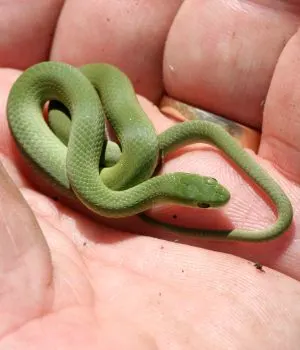
A uniform pattern is plain, with no markings. An example of a snake with a uniform pattern is the green snake. There are two species of green snake: smooth green snake (Opheodrys vernalis)and rough green snake (Opheodrys aestivus). Both snakes are non-venomous colubrids.
Stripes
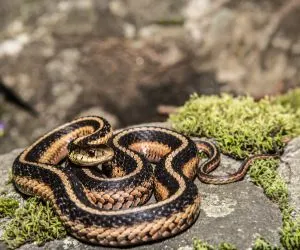
These have horizontal stripes on their body. These are long stripes that usually stretch the entire body. There may even be blotches between the stripes.
Banded/Rings
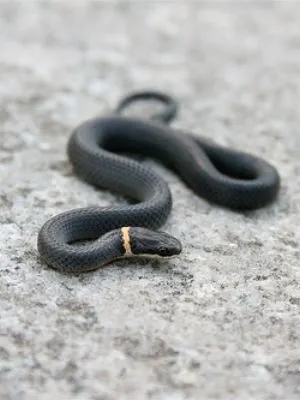
Some species have circle rings around their bodies. The rings or bands may not go around their body completely. Sometimes the rings may even look like wedges.
Diamonds
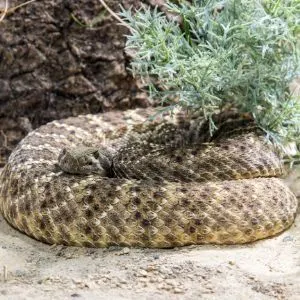
Some snakes may have diamond patterns on their backs. An example of such a snake is the diamond-backed watersnake. The eastern diamond-backed rattlesnake is another example.
Blotches

Another pattern is ‘blotches’. Here the markings on the snake’s scales appear to be blotches. Some North American snakes with this pattern include the bullsnake ( Pituophis catenifer sayi)
Texture, Size, & Shape
The shape of the body, as well as the size, can tell you a lot about the snake. Is the snake thick and heavy or is it slender? Also, take note of the texture. What are the characteristics of the snake’s scales? Are they smooth, shiny, dull, large, or small?
How to identify some common snakes
There are over 100 snake species in North America alone. Across the world, there are over 3,000 snake species. As you can see, there is no way we can cover all the species available. Here we will be looking at various snake types. The families we will be looking at include Leptotyphlopidae (blind snakes), Boidae (boas/pythons), Colubridae (colubrids), Elapidae (coral snakes/cobras), and Viperidae (vipers).
Colubridae (colubrids)
These are among the most common snakes in the world, both in terms of population and species. There are over 2000 species of this snake in the world.
Colubrids are nonvenomous snakes. They lack pelvic girdle and vestigial hind limbs.
Common Garter
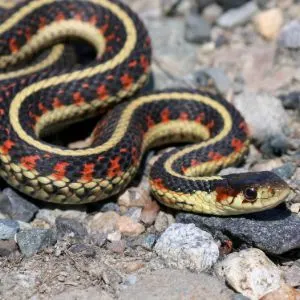
The scientific classification of this species is Thamnophis sirtalis. Garters are medium size snakes. These snakes are nonvenomous to humans. They are slender and reach average lengths of 88 cm or 35 inches.
Geographic range: These snakes can be found throughout much of North America. The only place in North America where they are mostly absent in the arid southwest.
Habitat: These snakes are excellent in surviving in a large range of habitats. These can be found in hillsides, woodlands, marshes, and meadows. However, they prefer moist grasslands. They are commonly found near water bodies. In suburban and suburban areas, you can find them in vegetation, under debris, rocks, and boards.
Color & pattern: They have three lengthwise lightly colored stripes on a dark background (olive, gray, brown, or black). The stripes are light brown, green, blue, yellow, or white. The stripes look more like checkerboard patterns instead of lines. The heads are uniformly colored.
Size & Shape: The head of this snake is wider than its neck. The snake usually grows to be 45 to 140 cm from head to toe.
Bullsnake
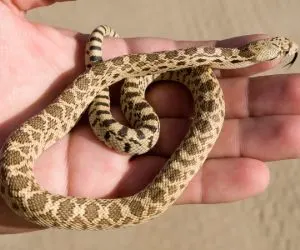
The scientific classification of this species is Pituophis catenifer sayi. This is a subspecies of the gopher snake and it is considered to be one of the more common snakes found in North America. This is a massive snake that can grow to lengths of 8 ft. These snakes are often confused with rattlesnakes. Unlike rattlesnakes, bullsnakes lack rattles & pit vipers and have narrow heads.
Geographic range: The bullsnake can be found in North America. Its range consists of the United States, Canada (desert regions of British Columbia. Alberta, and Saskatchewan). And northern and central Mexico.
Habitat: This species can be found in all types of habitats such as shrublands, prairies, deserts, woodlands, and chaparrals. They prefer to live near water bodies and moist habitats such as moist woodlands and marshes.
Color & pattern: This species has blotches on a light background. The blotches are black/brown. The light background is gray to straw (yellowish).
Size & Shape: These snakes are huge and can grow to lengths of 8 feet. The average length of this reptile is 4 to 6 feet.
Western Hognose
The scientific classification of this species is Heterodon nasicus. This is another species that is commonly confused with rattlesnakes. However, unlike rattlesnakes, the hognose lacks pit vipers and rattles. They are quite moderately sized snakes. They also have thick necks and small heads.
Geographic range: These snakes can be found from southern Canada to northern Mexico, specifically south Arizona, south Texas Iowa, Illinois, Missouri, Minnesota, and Arkansas.
Habitat: They are found in arid areas, grasslands, floodplains, and prairies. They are also known to frequent agricultural lands.
Color & pattern: The snake is marked by about 40 dorsal spots on light olive green or grayish brown background. The head features lighter coloration than the rest of the snake does. There are brown markings on top of the head and underneath the eyes.
Size & Shape: This snake grows to an average length of 50 cm or 19.7 inches.
Distinguishing Feature: The hognose has an upturned nose.
Milk Snakes
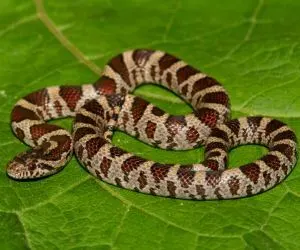
The scientific classification of this species is the Lampropeltis triangulum. This snake is a species of kingsnake. So-called because they are known to prey on other snakes.
Geographic range: They can be found in most places east of the Rocky Mountains.
Habitat: These snakes can be found in forested areas. There is the likelihood of finding them in open prairies, and rocky slopes, but this is rare.
Color & pattern: These snakes look banded. The alternating colors striking red, black, and yellow or white, black, and red.
Size & Shape: These snakes usually grow to lengths of 30 to 130 cm (or 1 to 4.3 feet).
Distinguishing Feature: These snakes are normally confused with coral snakes. However, in coral snakes, the black bands are much wider while with milk snakes, the black bands are very narrow. Coral snakes also have solid black faces.
Corn Snake

The scientific classification of this species is Pantherophis guttatus. This snake is endemic to the central and southeastern United States. These snakes are non-venomous and help in pest control. However, the corn snake is often confused with the venomous copperhead.
Geographic range: They are mostly found in Florida and its neighboring states. They can be also found in southern New Jersey to Florida, Louisiana, and Kentucky.
Habitat: They can be found in abandoned buildings, barns, woodlots, wooded groves, meadows, and rocky hillsides.
Color & pattern: These snakes have bright colorations (yellowish-brown or orange) with red blotches along the back. The underside features rows of alternating white and black marks. This gives the snake its common name.
Size & Shape: These snakes grow to lengths of 61 to 182 cm or 2 to 6 feet.
Distinguishing Feature: The corn snake can be differentiated from copperheads but the corn snake’s brighter colors, rounded pupils, slender build, and lack of heat-sensing pits.
Common Kingsnake

The scientific classification of this species is Lampropeltis getula. This snake is also known as an eastern kingsnake. These snakes are known to hunt and eat other snakes such as the venomous copperhead.
Geographic range: This species has a large geographic range. This snake is found throughout North America. There are several subspecies also available. These subspecies may be limited to parts of the United States and Mexico.
Habitat: These snakes are usually found in urban areas, deserts, grasslands, and forests.
Color & pattern: The common kingsnake is a solid glossy black reptile with yellow crossbars that can be found over its entire body.
Size & Shape: the common kingsnake can grow to lengths of 61 to 153 cm or 2 to 5 feet. As with other non-venomous snakes, the common kingsnake has round pupils and a narrow head.
Viperidae (vipers)
Vipers are highly dangerous snakes since they are venomous. Regardless, these snakes generally stay away from humans as we are more of a danger to them. Vipers have numerous small scales on their heads and vertically elliptical pupils instead of the round pupils found on other snakes. They also have two heat-sensing pits, each located between a nostril and an eye.
Copperhead

The scientific classification of this species is Agkistrodon contortrix. This snake is a pit viper and is usually confused with several nonvenomous snakes such as corn snakes. The copperhead is a small to medium-sized viper.
Geographic range: The copperhead is restricted to the central and eastern United States. They can be found in 28 states including West Virginia, Virginia, Texas, Tennessee, South Carolina, Pennsylvania, Oklahoma, Ohio, North Carolina, New York, New Jersey, Nebraska, Missouri, Mississippi, Massachusetts, Maryland, Louisiana, Kentucky, Kansas, Iowa, Indiana, Illinois, Georgia, Florida, Delaware, Connecticut, Arkansas, and Alabama. They can also be found in Mexico, specifically in Coahuila and Chihuahua.
Habitat: These snakes are generally found in woodlands and deciduous forests.
Color & pattern: these snakes have reddish-brown bodies. The crossband patterns are a deeper shade of brown, copper, or tan. These patterns can be found all over the copperhead’s body. The underside of this snake is ground color.
Size & Shape: the copperhead grows to lengths of 20 to 37 inches or 50 to 95 cm.
Distinguishing features: The reddish-brown coloration of this snake makes it stand out. To differentiate it from the corn snake, the copperhead has vertically elliptical pupils instead of round pupils and heat-sensing pits.
Rattlesnake
The scientific classification of this group of venomous snakes is Crotalus and Sistrurus. These snakes can be distinguished by the rattles on their tail. Once you can identify these rattles then you can tell that they are rattlesnakes.
Western diamondback rattlesnake

This species is responsible for most of the venomous bites in the United States. The scientific classification of the western diamondback rattlesnake is Crotalus atrox.
Geographic range: Rattlesnakes can be found throughout the Americas. The western diamondback is endemic to the southwestern United States in states such as Texas, Arizona, Oklahoma, California, New Mexico, and Colorado. In Mexico, they can be found in Veracruz, Hidalgo, and Sinaloa.
Habitat: This reptile generally lives in arid regions and can be found in grasslands, desert biomes, and chaparrals.
Color & pattern: The background color of this species is ground color, pale blue, or yellowish gray. They have diamond patterns on their back. These diamond patterns are dark in color but have pale borders.
Size & Shape: This is a plump snake with a rectangular head similar to other rattlesnakes. It also has a short tail. The average length of adults is 4 feet or 120 cm.
Boidae (boas/pythons)
These snakes are heavy and large. Very few wild boas or pythons are found natively in North America. The most common boid is arguably the ball python. This snake is only kept as a pet. There are countless morphs of this species. Examples of boids include boa constrictors, anacondas, Burmese pythons, and ball pythons.
Ball python

The scientific classification of this species is Python regius. This is a heavy snake. Although the geographic range of the species is West Africa, specimens are very common in North America on the pet trade. The docile nature of this snake makes it a favorite among snake enthusiasts.
Geographic range: This snake is endemic to West and Central Africa.
Habitat: Ball pythons usually inhabit open forests and grasslands. They usually spend most of their days in burrows trying to beat the heat, coming out at dawn and dusk. As cold-blooded animals, they aren’t very active during the night.
Color & pattern: These snakes have light brown blotches among darker brown spots. The background of this python is much darker than the blotches. However, there are countless morphs out there with a wide range of colors from pure white to even dark black.
Size & Shape: This python reaches lengths of 100 to 150 centimeters (39 – 59 inches). Most morphs kept as pets are usually smaller.
Wrapping up
Snake identification can be tricky. Several species look very similar and there are thousands of snake species all over the world and over 200 species in North America.
When identifying a snake, there are several characteristics and features to consider. These include the locality within which you found the snake, the habitat within which you found the snake, and the description of the snake. These include coloration, patterns, and even unique features.
If you wish to identify venomous snakes, watch out for the vertically elliptical pupils, heat-sensing pits between the eyes and nostrils, and the triangular head. Non-venomous snakes generally have round eyes, thick necks, and narrow heads.
Regardless, the only way to be 100% sure of the identity of a snake is to have an expert examine it.
If you have any questions or extra information, kindly leave a comment.
Table of Contents

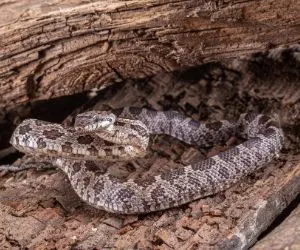
Alan S.
Thursday 20th of October 2022
..."Size & Shape: This python reaches lengths of 100 to 150 meters. Most morphs kept as pets are usually smaller." This is incorrect. This should be Centimeters, not Meters.
Snaketracks
Friday 21st of October 2022
Thanks for catching that.